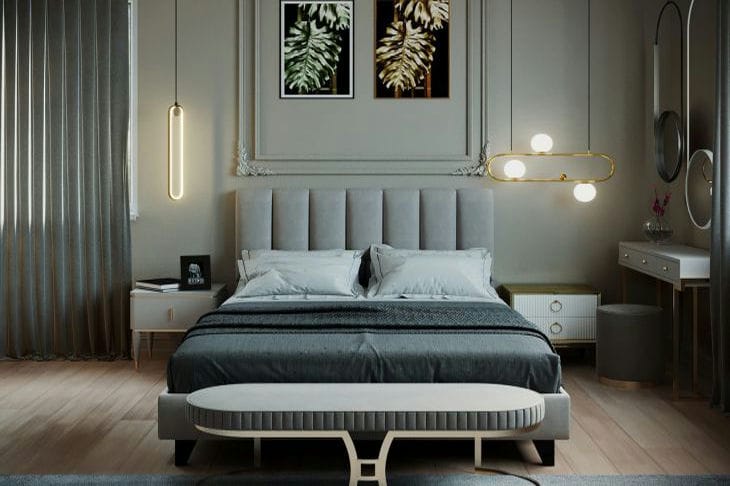Smart Bedroom Furniture Arrangement: How to Increase Productivity and Efficiency in Living
The quality of sleep is directly related to the productivity and efficiency of life. Therefore, the main goal of the bedroom should be to create conditions for the most comfortable and healthy sleep.
The placement of the bed in space plays a significant role in this process.
The first rule of bed placement is not to place it opposite the door. This creates a feeling of uncertainty and scattered energy.
The bed should be on a firm surface and leveled vertically. The best position for quality sleep is considered to be the head of the bed facing north.
In addition, do not place your bed right behind the windows, especially on the ground floors and in noisy areas. A view of nature or greenery shortens the time it takes to fall asleep and helps reduce stress levels. Use these simple tips and improve the quality of your sleep and life in general.

What furniture and how much is needed in the bedroom
Having certain items in your bedroom affects not only your comfort, but also your productivity. But how do you know what furniture you need? And how much of it should be in the room?
The basic piece of furniture in the bedroom is the bed. For a comfortable sleep, you should choose beds with an orthopedic base and a mattress that matches the person's weight and height.
In addition to the bed, it is important to have a wardrobe for storing things, bedside tables where you can place the necessary items and lamps to create a pleasant atmosphere.
In addition to basic ergonomics, remember that you should try not to place too much furniture in the bedroom. Excessive furniture will create a bulky image and clutter the body.
How the colors of a room affect people's emotional state
Some color palettes can have a positive or negative effect on us. Using colors in bedroom design can have a comprehensive impact on your emotional state and sleep quality.
Blue and green are the main colors that can be used in bedroom design. They have a calming effect and create a pleasant atmosphere that promotes healthier sleep conditions and more efficient work during the day.
Gray, pastel shades, brown and turquoise, depending on the timbre, can also help create a calm and cozy atmosphere. The use of bright colors and unnatural shades should be limited, which will help to avoid unnecessary irritation and stressful situations.
How to choose lighting for comfortable sleep
Lighting is a key design element and is important for quality and comfortable sleep. It is necessary to choose lighting that will not irritate and disrupt the natural working routine of sleep and wakefulness.
Using different light sources, with soft and more intense tones, will help create a comfortable atmosphere and improve ergonomics.
The main source of light in the bedroom is a ceiling lamp, which provides general lighting and does not create diffused light directed at the eyes.
In addition to ceiling lights, you should use table lamps on nightstands, which will help you adjust the light for reading, working or relaxing. Additional lamps with their own independent switching can also help create cozy conditions for sleep.
How to Clear Clutter and Create a Comfortable Space in Your Bedroom
Imagine a bedroom where everything is in its place and looks ergonomic. No extra items cluttering the space, falling on the bed or scattered on the floor? Removing clutter in the bedroom can affect the perception of comfort and create an ergonomic space for quality sleep.
The bedroom should be a place where you can relax, unwind, and forget about your problems and worries. Make sure that there are no piles of things or small items on the nightstands, in the closets, or on the floor that can create clutter and discomfort.
A strong fragrance, fresh linens and flowers help create a more comfortable sleeping environment and improve the ergonomic placement of things in the room.
Previously we talked about removing grass stains from pants.
